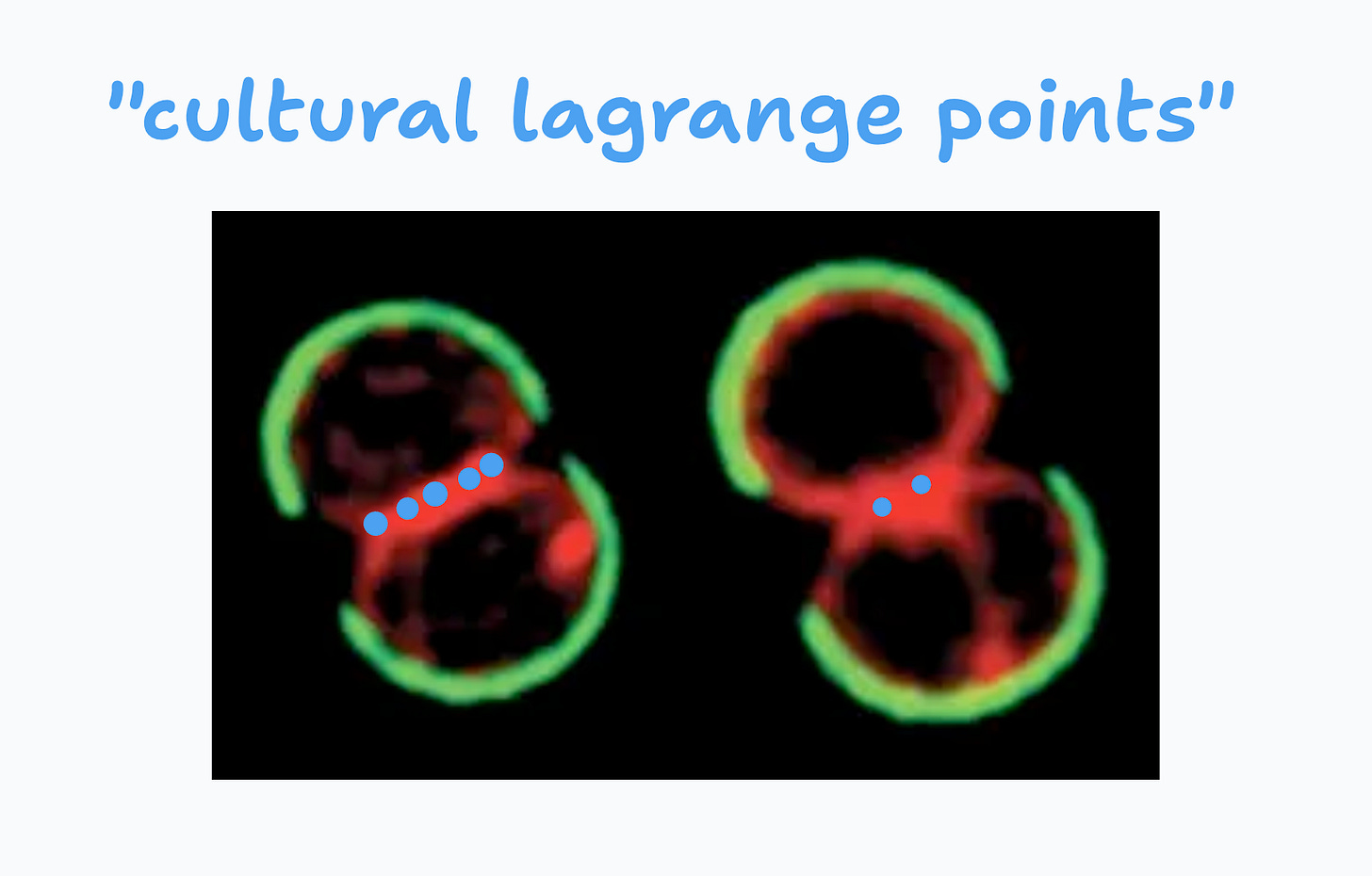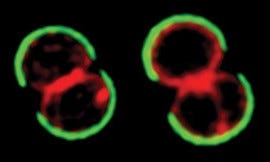On which side of the fault line are you?
In “High-Dimensional Foraging” Robin Hanson describes a model of the reality that I believe we exist in: a vast universe, a very small slice of which we can perceive. We have to figure out how to survive knowing there are things outside of our perception.
Because of how many branching paths there are, taking the one you think is best at each fork gives you low odds of survival:
Creatures who just randomly travel this network searching for food, backtracking when they reach dead-ends, face high risks of running out of food and dying
The creatures that survive in this world are ones that can interconnect and exchange information. They explore ALL the paths, and the ones that find food & safety alert the others.
This is a great frame to understand the function of culture. It fulfills the “interconnect & exchange information” part, maximizing the survival of the “group”, through the cooperation of its members.
Ok so we figured out a way to maximize our survival, hooray! But this comes with an existential question for the individual:
Which group should you follow?
When do you switch paths?
I used to tweet this image a lot, of cells dividing. I think about it as a visualization from the Human Memome Project. I imagine graphing our networks, like “liberal” would be one big cell/network. MAGA would be one cell, and tech bro’s/silicon valley are another cell, which have merged together thanks to Elon Musk & Trump1.
Robin Hanson explains that a monoculture has low odds of survival, because it’s the same as one individual exclusively making the choices that maximize their own survival. So, the splitting isn’t a bad thing, in the grand scheme of things. It ensures that one of you will survive.
But still, if culture is splitting, and I’m sitting here in the middle: what should I do?

The ideal outcome is to retain information exchange. Even if you’ve split, if it turns out one is going down a path that cannot survive, then the other group wants to know that, so that they never take that path in the future (if they ever need to backtrack, they should pick a different path). Ideally you can save some people if some can turn back just in time.
Q: Is this person that exists between tribes standing at the safest spot?
A:
Yes: if you observe both, and can jump onto whichever side is going to survive
No: if the cultures split too much, and you end up alone, you have the lowest odds of survival
If you personally can see this happening, a great split, do you try to weave it back, or do you try and just jump ship, taking as much intel as you can from the other ship?
Over 10 years ago Jordan Hall “
” asked “what is the best culture?”. He explained then the same thing I am trying to explain now: this is not a subjective question, it’s a question of survival.One of the worst things that can happen in a culture war is the following scenario:
A culture splits
Group 👿 goes down a path that is known to lead to destruction
Group 😇 fails to propagate this information to 👿. Group 😇 ends up losing a lot of its members to the fork
Group 👿 sees the path of destruction, but it’s too late to turn back
Group 😇 doesn’t have enough members to survive, they also die, despite having picked the right fork
Lose lose. All is lost.
Now, if there existed any culture that watched this whole thing unfold, they should be able to use that information to avoid the same thing happening to them.
As long as they can remember this, & pass it down every generation.
This is why I am really obsessed with the memome project. I can see culture evolving. I can see people openly operating on it, like Hank Green, and Elon Musk. I can also see others operating on it who wish to not be known2.
And I just want to know, which side of the fault line am I on? And what is happening on the other side?
I’ll leave you with this a bit more positive: an attempt to find a cute way to explain the memome project that might make sense with everyone.
the human memome project is about going viral once in every cluster. That way you always know on "which side" of it you are
(they've successfully reached you, or they're not there yet)
You can see why this matters in the context of branching paths of survival: when something does happen that everyone wants to spread, on both sides, can it spread?
I wrote this after I accidentally went a little viral outside of my normal audience. The tweet below got popular in what you might call “spiritual woo woo girl” culture:
every time you need something, "the universe" delivers. First you think it's a coincidence, then you start seeing a pattern, it happens consistently, you think it's magic. Then you realize, you're a cell inside an organism that can respond to you. Duh
When I write on twitter I try to write in a “common tongue”. Not towards a monoculture, but towards finding information exchange networks between cultures (the “lagrange points”).
This tweet above is a statement that feels true for many people, but sounds insane to the materialist/scientist/rationalist crowd. But it can be translated, if you can speak both languages. The “organism that can respond to you” can be understood as any structure that facilitates coordination between you & people like you. So, the company that you work for. Or the country you’re a citizen of. Or more broadly, the culture/ideology you’re a part of.
It’s obvious that if your needs are aligned with your collective, the collective will support you, even if no “individual mind” is making that decision intentionally, the “collective mind” (or what I call “egregore”) is making that decision.
This is what I hinted at in the Hank Green essay, of how decisions are made, jointly between individual & collective:
So, this is the game. In order to remain trusted & influential, you have to align with the existing current. But doing so also reinforces the current. If the current is moving in the wrong direction, trying to pull it too hard just gets you ejected, and lots of content creators will happily fill the void to capture attention / money & make a living, reinforcing the current.
From “How Hank Green is contributing to the Human Memome Project”
When a human makes a decision, sometimes the source of that decision is from “below” (your gut, you are hungry, etc). Sometimes the source is “above” (the ideology that wants you to help it survive, even if you will not survive).
I think this is what makes humans “the middle way” between heaven & earth.
…but perhaps may be splitting again now. If we had these networks visualized we could “see the velocity” or direction and see what the shape of the superorganism really looks like.
This is a huge advantage that those of us working in “open memetics” have: those working in the dark by definition CANNOT succeed without leaving *some* evidence of their work, by the change itself that they are trying to effect. Shining a light on this interferes with their work. Whereas, for those working in the open, shining a light on it accelerates it. We can use this asymmetry to our advantage. This gives us a fighting chance even if the others have orders of magnitude more resources.




I partially agree. I think this has some holes:
Information can be beneficial (and support survival) only when there are checks on the behavior that it inspires. If my brain only pays attention to how delicious food is and never gets that fullness memo (which is all just signals), I could eat myself to death.
When humans got better at accessing calories, some cultures developed taboos against taking too many calories from their surroundings. To support that goal, they had natural methods of abortion, and infanticide was fair game, and it was normal for the elderly to *disappear*.
Your/my culture ditched this restraint, and spread to become the dominant culture for 8B people - not because anyone ever determined that it's leading anywhere nice in the long run (it's leading somewhere very ugly!), but because it unleashed our ability to (briefly) overrun everyone else.
“interconnect & exchange information” --> cooperation --> maximize 'group' survival" ... is true long-term only if all living things see each other as group members. If only one species (Homo sapiens) is sharing Success Tips internally while ignoring the "hi you're driving us extinct" signals from other species, human success is merely temporary and then most species (very well including the humans) get wiped out - so much for (any) "group" survival.
I once again thank you for this reframing exercise especially about engaging with the current culture. Between heaven and earth is a very powerful framework